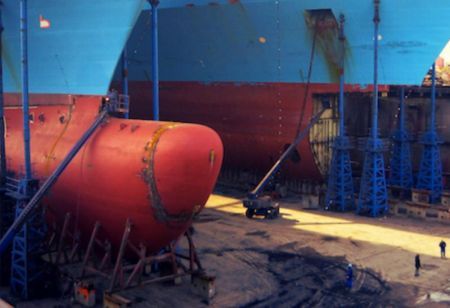
Five Maersk Line vessels are getting a ’nose job’: having their bulbous bows retrofitted to improve fuel consumption. For one of these, the operation involved moving the new ’nose’ from Asia to Europe – on a container vessel, of course.
Saurabh Khanna works for Maersk Line Ship Management in Singapore as Senior Technical Project Manager. When his team was told to modify the bulbous bow on five Boston class vessels, they got to work right away.
Improving vessel performance
The change would improve the performance of the vessels significantly, with fuel costs reduced by approximately 8 percent in the current slow-steaming environment. The vessels were too expensive to use, since they were designed for high speed. If they were retrofitted, however, Seago Line were interested in taking five vessels.
Four of these vessels had their ‘nose job’ performed in Qingdao, China, and have now been delivered to Seago Line. But the last one proved a bigger challenge, as it was lying idle in Europe. The cost of bringing the Maersk Brownsville to Asia was too high, but so were the quotes offered by European yards for the operation.
The solution was simple in theory, albeit challenging in practice, says Saurabh: “If we cannot bring the vessel here, let us take the bulbous bow there”
Moving a 200 tonne nose
Some rough figures help justify the operation. Manufacturing the bulbous bow in Europe would cost USD 2.34 million vs. USD 470,000 in China. Transporting the 200 tonne bow from China would cost USD 550,000 on a bulk carrier, whereas installing it in Europe would cost USD 910,000. From this the case for shipping it from Asia to Europe, but using a Maersk Line vessel instead of a bulk carrier would mean even further savings, with amounting to total expected savings of USD 960,000.
With a clear mandate, the team set out to overcome the technical challenges involved in shipping the nose – in five parts – on one of the previously retrofitted vessels, the Baltimore (now Seago Felixstowe), headed for Europe. “We had to liaise with the break bulk team to find out if it was possible,” says Saurabh. “Once confirmed we had to liaise with deployment and planners.”
“Initially we were not allowed to load these blocks at the shipyard they were manufactured, as China customs only allows loading at designated container terminals.” But also that challenge was overcome.
Discharging the blocks in Europe was not a piece of cake, either. The discharge port, Setubal in Portugal, could not accept a fully loaded vessel, so an alternative had to be found, says Saurabh. “In collaboration with vessel planners we managed to keep the vessel just below the minimum draft requirement for the anchorage. Working at high tide, a barge and floating crane then carried the blocks off the vessel to the shipyard, where the Maersk Brownsville was waiting.”
The Maersk Brownsville is expected to be ready with its new energy-efficient bulbous on 8 February, and will enter service as the Seago Piraeus.
We use cookies to improve your experience. By continuing to use our site, you accept our Cookies, Privacy Policy,Terms and Conditions. Close X